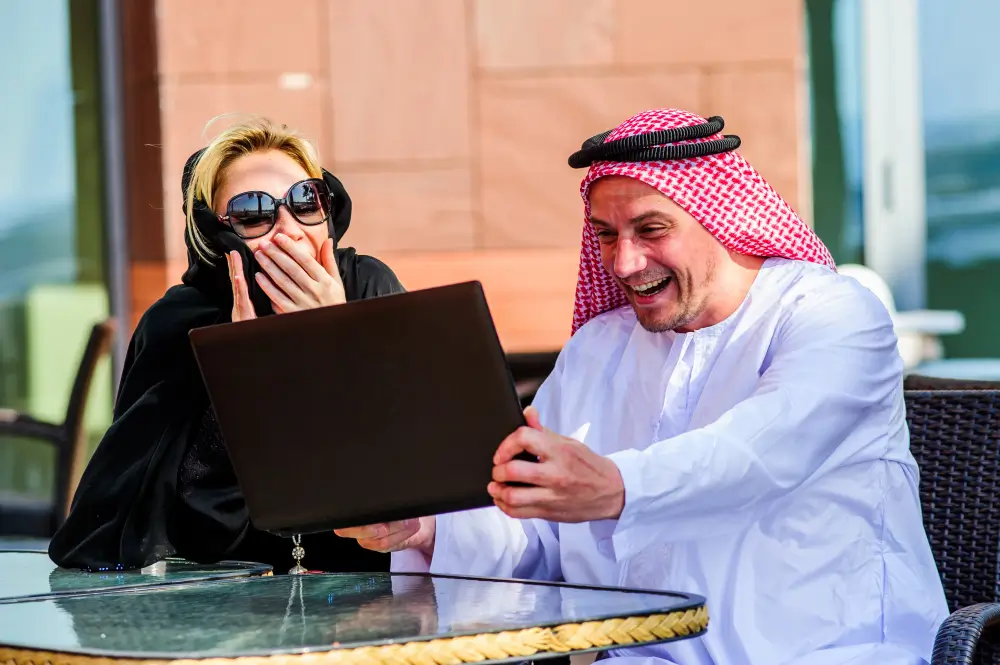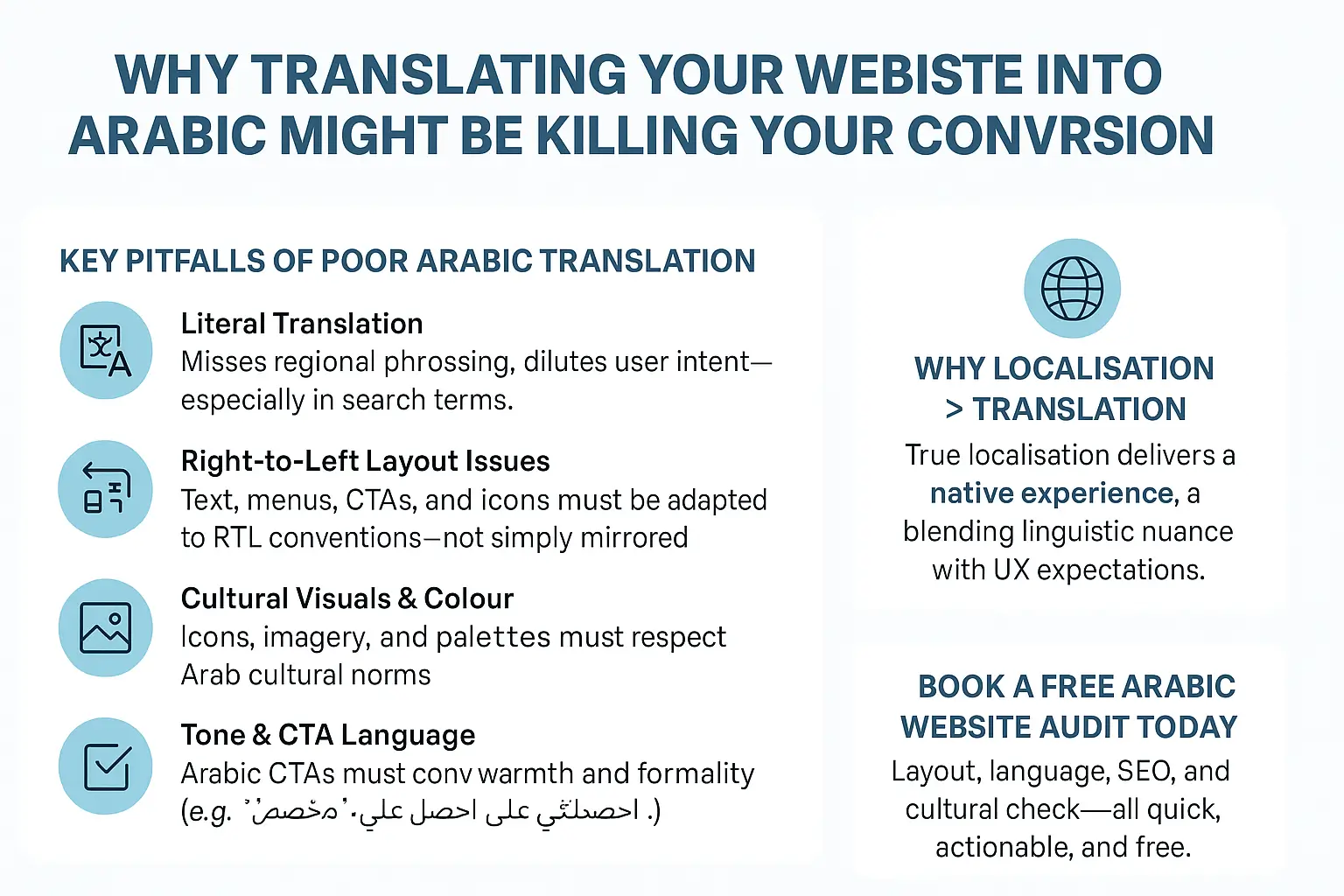
TL;DR: Translating your website into Arabic without proper localisation can damage trust, confuse users, and reduce conversions. A successful Arabic site needs cultural awareness, layout adjustments, and SEO that fits local search behaviour. It’s not just about language but about giving users a familiar and intuitive experience.
Key Takeaways:
Many businesses expand into the Middle East thinking they’ve done their due diligence by simply translating their website into Arabic. But here’s the catch: translation alone doesn’t cut it.
If you’re not tailoring your website experience for your Arabic-speaking audience, you’re not just missing the mark; you might actually be pushing potential customers away.
Website localisation goes beyond switching words. It involves adapting your content, design, and functionality to align with regional expectations, cultural norms, and language flow.
If your goal is to convert users in the UAE and broader Gulf region, especially in Dubai, localisation isn’t optional.

When you optimise for Arabic search terms like “ترجمة موقع من الانجليزية الى العربية” (website translation from English to Arabic), it’s not just about finding the right words. Arabic follows a different sentence structure and rhythm, and people use search engines in culturally specific ways.
This means that literal translations often miss the nuances of what users actually intend to find. Without understanding how Arabic speakers frame their queries, your content could show up in the wrong searches or fail to rank entirely.
Arabic is written and read from right to left, which directly impacts how your website should be designed. Simply flipping text alignment is not enough. Here are some elements that need proper adjustment:
Many website templates aren’t built with RTL compatibility in mind. Attempting to force them can result in broken layouts, awkward spacing, or misaligned elements.
These issues not only frustrate users but may also confuse search engine crawlers, which could impact how well your site is indexed.
Terms like “website translation Dubai” and “Arabic localisation” are good starting points, but they don’t capture the full picture. Audiences in Dubai might search differently than those in Saudi Arabia or Egypt. Regional dialects and phrasing play a big role in how people type search queries.
A bilingual SEO expert can help uncover terms that may not be obvious through standard keyword tools, including long-tail keywords and location-specific variants that improve visibility in local search results.
If your business handles sensitive content like contracts or compliance materials, see our guide on accurate legal contract translation in Dubai for tips on avoiding costly mistakes.
Visuals play a big role in shaping how your audience perceives your brand. Certain imagery that works well in Western countries might not be appropriate or relatable in the Gulf. Here are a few examples that could cause a disconnect:
When visuals clash with local expectations, even unintentionally, they can erode trust. That disconnect may cause users to lose interest and leave your site.
Colours communicate silently, and in Arabic cultures, they carry deep meanings. Green is widely viewed as a symbol of prosperity, peace, and is closely tied to religious identity.
It’s a safe and often appealing colour for Gulf audiences. Red, on the other hand, while energetic in Western branding, can come across as too aggressive or even alarming in some Arab regions.
Choosing the wrong colour palette might not just affect aesthetics but also how trustworthy or inviting your website feels.
A call-to-action is where you ask your visitor to take the next step. While “Get a Free Quote” might seem simple and effective in English, in Arabic it can feel too blunt. The Arabic language leans towards formality and warmth, especially in business communication.
A phrase like “احصل على عرض مخصص لمشروعك” (Get a tailored quote for your project) feels more considerate and aligns better with the tone Arabic-speaking users expect. The right CTA wording can make users feel valued rather than sold to.
A sleek sans-serif font might make sense for English content, but Arabic script has different demands. It flows differently and contains more curves and connections between letters. Choosing a font that looks natural in Arabic helps users read more comfortably, especially on mobile devices where clarity is critical.
People who read Arabic naturally expect menus, buttons, and navigation to start on the right. This applies to everything from your homepage layout to breadcrumb trails.
If your design forces users to look left for a “Next” button or scroll awkwardly to find the menu, it slows them down and makes your site harder to use. Getting the layout right helps visitors feel at home and more likely to stay on your site.
Tone is more than just the words you use; it’s how you connect with your audience. What feels casual or clever in English might come across as confusing or inappropriate in Arabic. A localisation expert doesn’t simply swap words between languages.
They help carry over the tone and intention in a way that respects cultural norms. If your brand sounds professional in English, the Arabic version should carry that same impression with the right level of formality and warmth.
For more on how translation supports market growth in the UAE, see our article on business translation in the UAE.

We don’t just translate; we localise. At Vision Translation, our team of native Arabic linguists and digital experts works closely with your content, marketing, and development teams to make your brand genuinely resonate with Arabic-speaking audiences.
Our experience spans industries like legal, healthcare, education, and e-commerce.
Our website localisation service is rooted in our broader expertise in professional translation. Whether it’s legal documents, certified translations, or technical content, we apply the same level of linguistic accuracy and cultural awareness.
You can learn more about our core services on our Translation Services page.
Is your Arabic site losing leads? Let us take a look. We’ll review your site’s language, layout, SEO, and cultural alignment. Our audits are fast, free, and actionable.
Contact us today and see how your website can work better for Arabic-speaking customers in Dubai and across the region.
